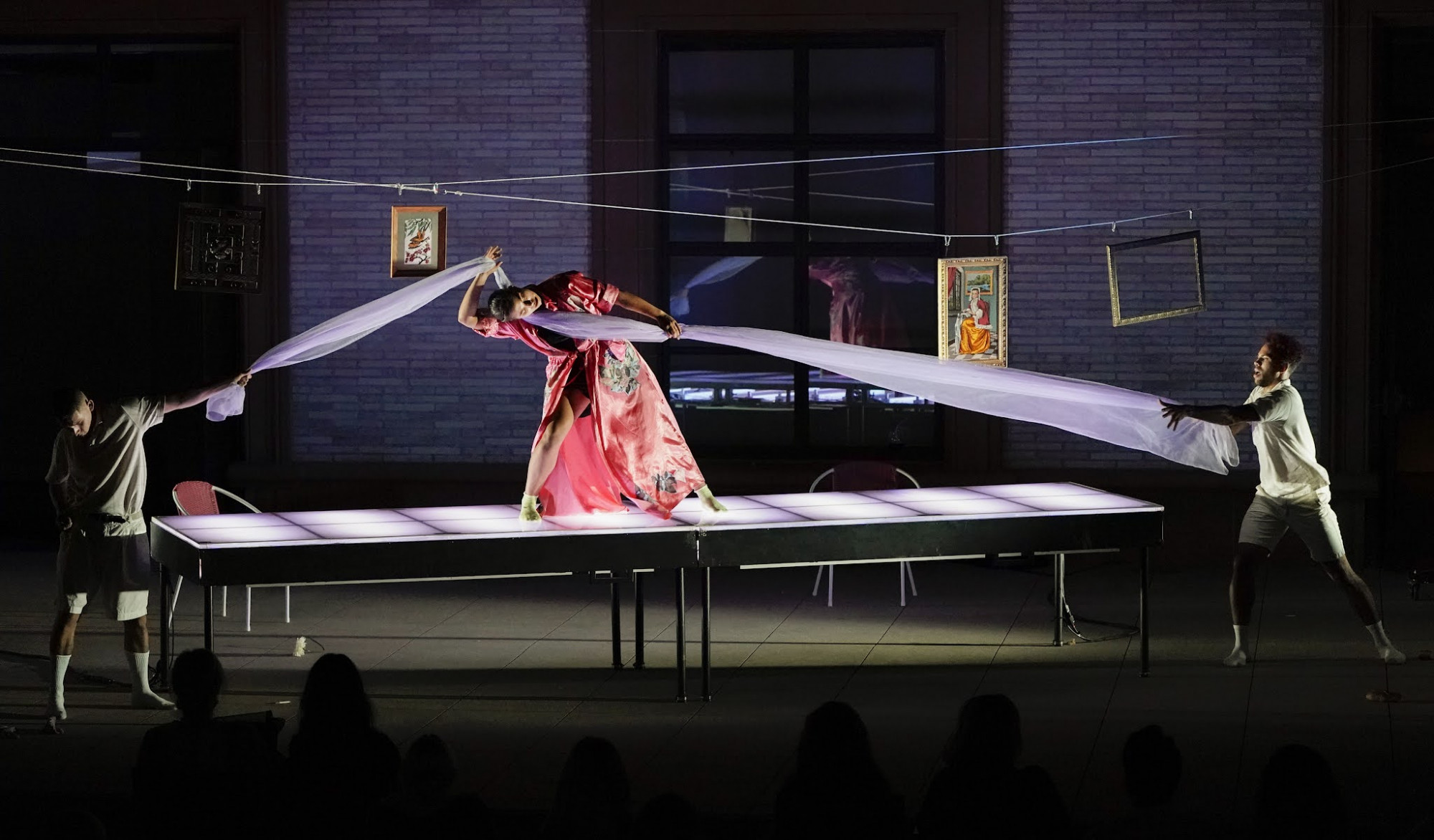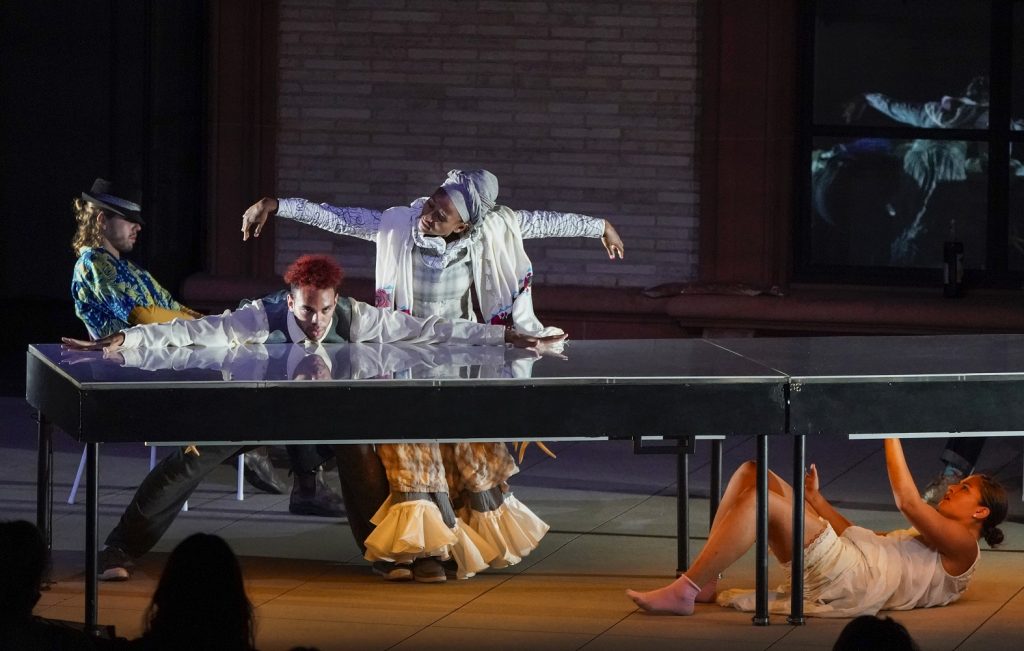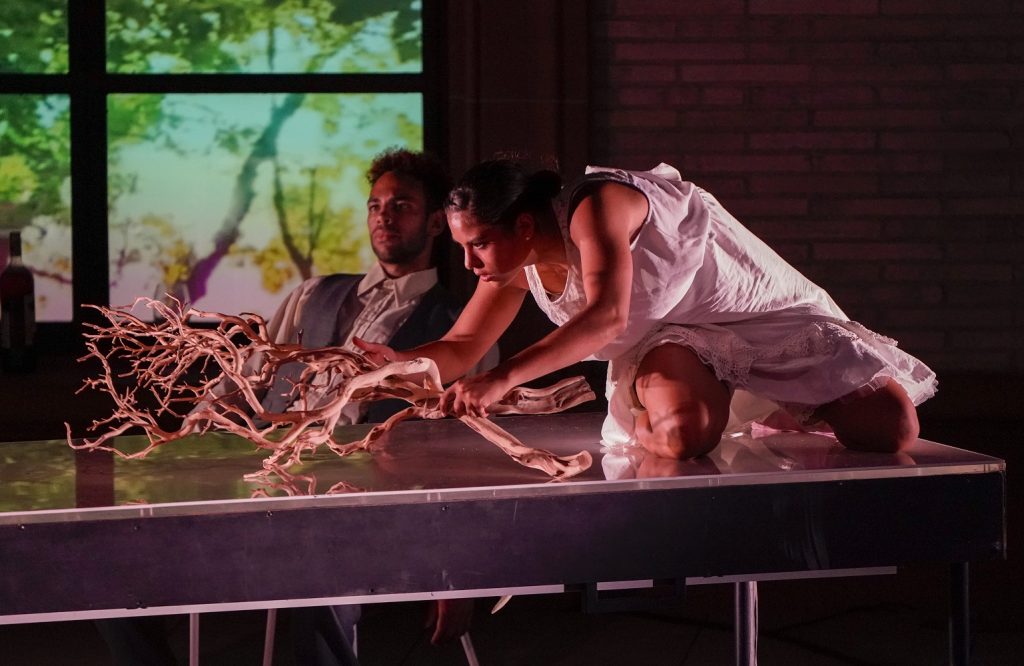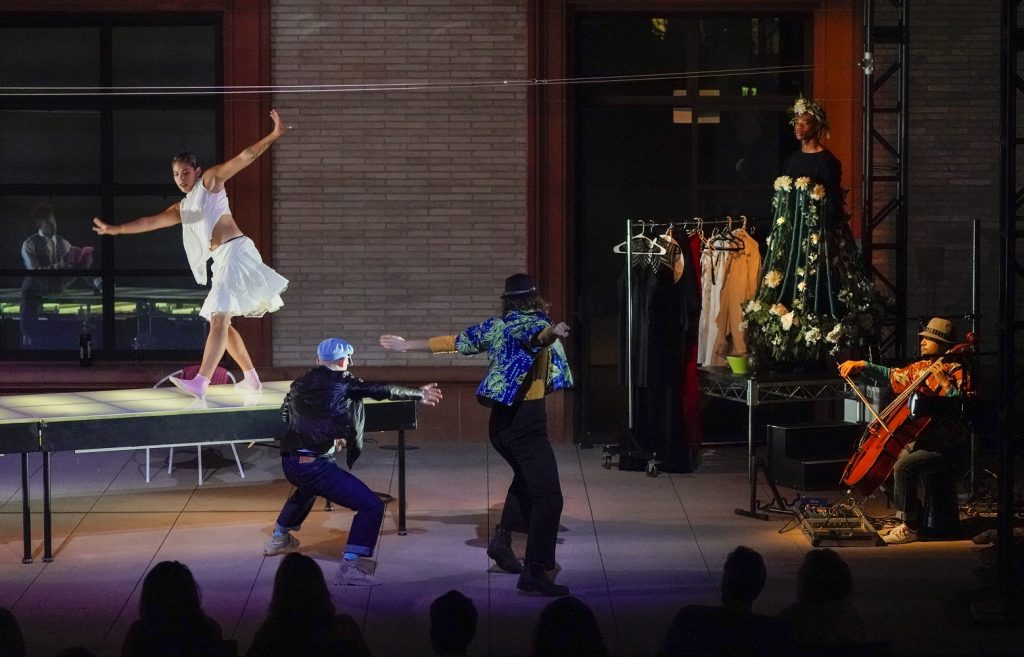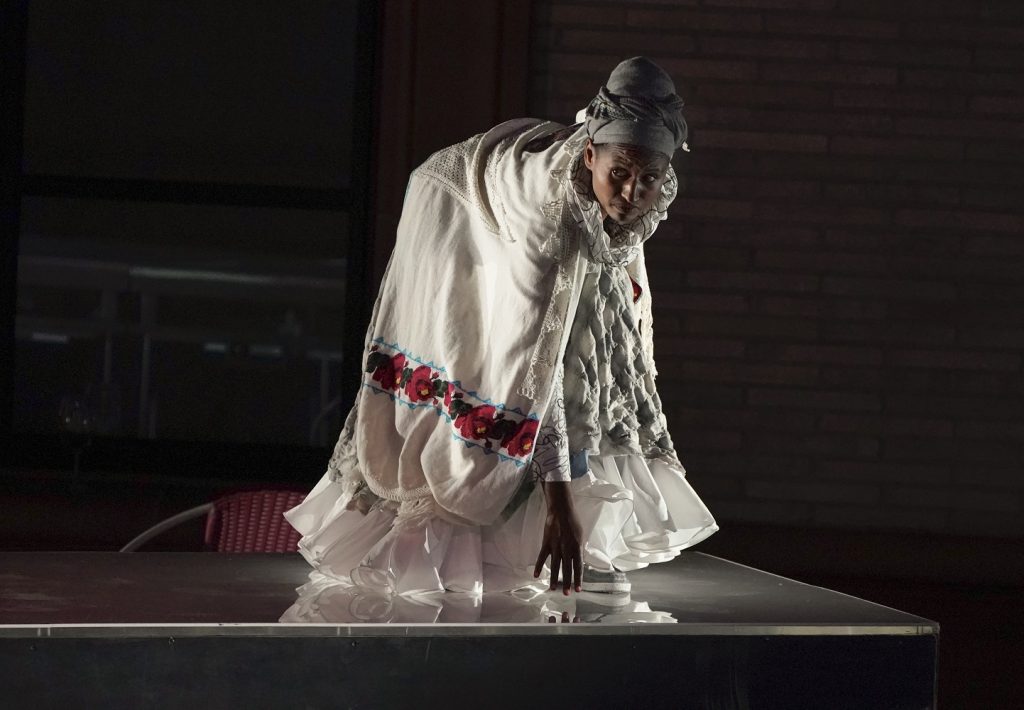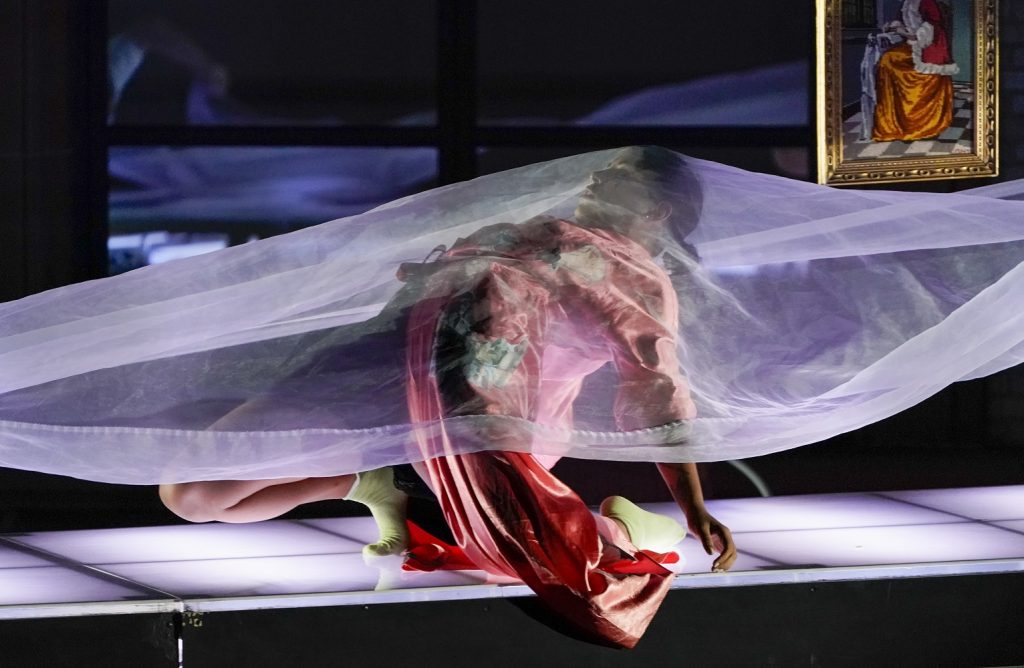To read in the LA Dance Chronicle
Director/Choreographer Heidi Duckler brought an intense performance piece to the Wallis Annenberg Center For The Performing Arts this past weekend. “The Chandelier” by Brazilian writer Clarice Lispector is the 1946 novel from which Duckler drew inspiration. Meant to be a site-specific work she was confined to an outdoor patio area alongside the theater in order to be in compliance with current Covid 19 restrictions. This proved to be no problem as the space is as beautiful as the theater itself and with perfect sight lines and a cool breeze the setting could not have been better. Even the noise of passing traffic was forgotten as “The Chandelier” got underway.
Taking on the work of a literary icon of Ms. Lispector’s stature is a brave and dangerous task and yet Heidi Duckler has done just this. The dense, brooding nature of Lispector’s work can be hard to penetrate as she works in a stream-of-consciousness style, which can draw in but sometimes lose the reader along the way. This too is true of Duckler’s attempt to bring the story to the stage yet, an indelible mood is set and is hard to shake even when the show is long over. The story is a basic one; a young woman navigates her way through family dysfunction, unfaithful lovers, pregnancy, a return home and an untimely death, all told through her raging internal dialogue.
(L-R) Adrian Hoffman, Javan Mngrezzo, Himerria Wortham, Nicole Flores – Heidi Ducker Dance world premiere of “The Chandelier” at the Wallis Annenberg Center for the Performing Arts – Photo by Lawrence K. Ho
The stage is set with an immense table, lighted from within, which becomes the main staging area and our primary focus. Raised platforms with intriguingly full costume racks at their side flank the table while a clothesline stretches overhead from platform to platform. Tall lighting trusses form a scaffold-like proscenium from which hung a large cluster of lighted bulbs, “The Chandelier.” The wall of the theater building with its three large reflective windows creates an ethereal backdrop.
The music composed and played by cellist Isaac Takeuchi sets a mood of discontent and foreboding. Playing an electrified cello Takeuchi creates layers of sound more than filling the space. The tempo remains slow and languid throughout sometimes falling into monotony and occasional intonation issues. A more frequent use of tempo change and a melodic theme would be welcome and would help to bind the story together.
(LtoR) Javan Mngrezzo, Nicole Flores – Heidi Duckler Dance world premiere of “The Chandelier” at The Wallis Annenberg Center for the Arts – Photo by Lawrence K. Ho
Dancer, Nicole Flores embodies her character, the young “Virginia,” completely as she grapples with her interior life of turmoil. She is a capable dancer but moreover an actress who imbues the part with pathos and real emotion. We feel for her with her cold Mother, Himerria Wortham and wild sexy brother, striking dancer Javan Mngrezzo, both who dominate her life. Through the use of the changing of clothes from the child’s dress to a woman’s suit of sophistication, we see the struggle to grow up in a remarkable sequence of movement as she dresses and undresses and dresses again. Throughout “Virginia” is aided by the “Nucleus” Kaitwan Jackson and Jessica Emmanel, who literally pull the strings of the clothesline and thus her life.
(LtoR) Nicole Flores, Alejandro Perez, Adrian Hoffman, Kaitwan Jackson, Isaac Takeuchi – Heidi Duckler Dance world premiere of “The Chandelier” at Wallis Annenberg Center for the Arts – Photo by Lawrence K. Ho
Individual or counter point dancing defines much of the choreography so it comes as a relief when dancers Alejandro Perez, “Vincente” and his friend and lover “Adriano,” Adrian Hoffman dance in unison. Lighting up the stage with both technique and presence, they flirt and taunt “Virginia” confusing and later enticing her into a sexy but overlong “ménage a trois.” When “Vincente” and “Virginia” break off into a duet of love the sensuality should ratchet up but instead feels like a repeat of what has gone before this time minus one lover. Earlier we see “Vincente” and Adriano in a salacious lovers duet that uses a baguette in unexpected and not very appetizing ways. The suggestiveness of the movement could be disturbing to some but actually never crosses any real boundaries, which leaves the audience just where the author and Duckler intended.
Himerria Wortham – Heidi Duckler Dance world premiere of “The Chandelier” at Wallis Annenberg Center for the Arts – Photo by Lawrence K. Ho
Duckler is endlessly inventive and skilled in the use of props and surroundings. The table looms large throughout the plot and she uses its every surface in surprising and satisfying ways. The eating scenes alone are testament to her quirky creativity. And the same can be said of the clothesline and the clothes that stream along propelling the story forward. Lispector’s novel is filled with symbolism that does not always work here, as we do not have enough of the backstory. Therefore the antlers and jacket of hats among others leave us wondering.
Duckler uses dance to inform and not to show off technique although all her dancers are excellent. For this piece she uses a lyrical modern, jazz style that reaches, rolls, and shows physical strength and yet does not go as far as possible and is dangerously close to moments of redundancy. Using more than one tempo within the music, adding a few unison segments for breathing space and power and elevating the choreography to incorporate more technical skill would bring this already remarkable piece to another level.
Nicole Flores – Heidi Duckler Dance world premiere of “The Chandelier” at Wallis Annenberg Center for the Arts – Photo by Lawrence K. Ho
Overall this is an illuminating work that often reflects Lispector’s dreamscape of words; “a cone of brightness was lighting a whirlwind of dusts that were dancing with hallucinatory slowness.” “The Chandelier”
The Excellent Creative and Technical team included: Voiceover/Narration Paula Rebelo; Costume Designer Snezana Petrovic; Technical Director Jake Siekman ; and Lighting Designer Kam Ying Lee.
The Wallis Production Team: Technical Director Matt Waldron; Production Supervisor Samantha Else; Audio Visual Supervisor Gary Markowitz; Lighting Coordinator Lauren Wemischner; and Assistant Technical Director Claudia Peterson.
To visit The Wallis Annenberg Center For The Performing Arts, click HERE.
Written by Tam Warner for LA Dance Chronicle.
Featured image: (L-R) Alejandro Perez, Nicole Flores, Javan Mngrezzo – Heidi Duckler Dance world premiere of “The Chandelier” at Wallis Annenberg Center for the Arts – Photo by Lawrence K. Ho

